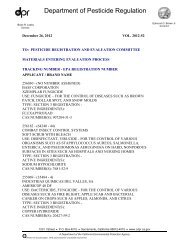Dichlorvos (DDVP) Risk Characterization Document - California ...
Dichlorvos (DDVP) Risk Characterization Document - California ...
Dichlorvos (DDVP) Risk Characterization Document - California ...
Create successful ePaper yourself
Turn your PDF publications into a flip-book with our unique Google optimized e-Paper software.
Acute Toxicity<br />
Inhalation<br />
The critical NOEL for acute inhalation exposure was derived from the two experiments on the<br />
developmental toxicity of rabbits where the does were exposed to <strong>DDVP</strong> for 23 hours/day (Thorpe et<br />
al., 1971b). The two experiments were considered together to derive the acute NOEL since they were<br />
conducted by the same laboratory with the same protocol. In the first experiment, mortality and<br />
cholinergic signs (16 of 20 does) occurred in the 6.25 ug/L (3.25 mg/kg-day) group after 6 days. The<br />
does were severely intoxicated. In the second experiment, 1 of 20 does in the 2 ug/L (the lowest dose<br />
tested, 1.0 mg/kg-day) group died after 2-3 days. No cholinergic signs were reported. Therefore, the<br />
no effect dose of 1.25 ug/L (0.65 mg/kg-day) from the first experiment may be used as the NOEL with<br />
the LOEL at 2.0 ug/L (1.0 mg/kg-day) determined by the second experiment. These studies were<br />
considered unacceptable to DPR as developmental toxicity studies, but do provide useful information<br />
on acute toxicity. Since there is insufficient information on the potential contribution to the exposure<br />
due to grooming and contamination of food and water by <strong>DDVP</strong> in the air, the air concentration<br />
provides the only estimate of actual exposure level by inhalation. The adjusted NOEL for risk<br />
assessment was 0.325 mg/kg-day (NOEL of 0.65 mg/kg-day x 0.5) based on a default inhalation<br />
absorption factor of 50% used for worker and residential exposures (Appendix B).<br />
Other acute studies (Table 2) showed rats with mild signs of toxicity (lethargy and pupillary<br />
constriction) after exposure to 90 ug/L for 4 hours (18 mg/kg-day), and the NOEL was 50 ug/L (10<br />
mg/kg-day). Studies conducted with hospital patients showed that exposure to <strong>DDVP</strong> resin strips for<br />
24 hours resulted in the inhibition of plasma ChE with a NOEL of 0.02 mg/kg-day for men without liver<br />
disease and of 0.014 mg/kg-day for sick children (Cavagna et al., 1969). Since plasma ChE inhibition<br />
is considered an indication of exposure rather than toxicity (USEPA, 1990; Brimijoin, 1992), this study<br />
was not used to determine the critical acute NOEL.<br />
Oral<br />
The critical NOEL for the assessment of acute oral exposure was 0.5 mg/kg-day in the neurotoxicity<br />
studies in rats for cholinergic signs (tremors, salivation, neuromuscular deficits, and others) observed<br />
within 24 hours in both the range finding and definitive studies (Lamb, 1992; and Lamb, 1993a).<br />
In the dog chronic study, soft stools were observed in the first week (Markiewicz, 1990). None were<br />
observed for the control and the 0.05 mg/kg-day group. However, this endpoint was not considered<br />
biologically significant as an acute effect because of the low incidences during the first week and lack<br />
of dose response relationship. In the rat developmental study, the NOEL was 3.0 mg/kg-day for<br />
tremors observed within 10-60 minutes in rats given 21 mg/kg-day by gavage (Tyl et al., 1991a).<br />
Clinical signs were observed in rats 2.5 hours after an oral dose of 21 mg/kg by gavage with a NOEL<br />
of 0.8 mg/kg-day (Cheng 1989 and 1991) or 10-20 minutes after a single dose of 30 mg/kg (Tracy et<br />
al., 1960).<br />
Subchronic toxicity<br />
Inhalation<br />
The critical NOEL for subchronic inhalation toxicity of <strong>DDVP</strong> was 0.25 ug/L (0.13 mg/kg-day) based on<br />
brain ChE inhibition (Thorpe et al., 1971b). There was a significant (p @ 0.05) and dose-related<br />
inhibition of plasma, erythrocyte, and brain ChE activities in the 1.25 and 6.25 ug/L dams after 29<br />
days of exposure. The inhibition of brain ChE activity was dose-related and statistically significant (p<br />
@ 0.05); and was 44% and 15% of control values for the 1.25 ug/L (0.65 mg/kg-day) and 6.25 ug/L<br />
(3.25 mg/kg-day) groups, respectively. The adjusted NOEL for risk assessment was 0.065 mg/kg-day<br />
56
















